
| What is Flavor and Fortune? |
| How do I subscribe? |
| How do I get past issues? |
| How do I advertise? |
| How do I contact the editor? |
Read 13059444 times
Connect me to:
| Home |
| Articles |
| Book reviews |
| Letters to the Editor |
| Newmans News and Notes |
| Recipes |
| Restaurant reviews |
| Article Index (all years, slow) |
| List of Article Years |
| Article Index (2025) |
| Article Index (last 2 years) |
| Things others say |
| Related Links |
| Log In... |
| Authors |
| Categories & Topics |
Mushrooms: Familiar and Less So--Part III
| by Jacqueline M. Newman |
Vegetables and Vegetarian Foods
Summer Volume: 2011 Issue: 18(2) page(s): 20 - 31
The first part of these articles about mushrooms loved by the Chinese appeared in Volume 17(4). It explored eight different mushrooms including the Chinese black or black forest mushrooms, also known by their Japanese name of shiitake mushroom, and seven others including the bamboo pith, the button, chicken of the woods, cloud ear, cordyceps, golden winter, and lion's mane mushrooms. Part II of this title appeared in Volume 18(1) and showed and discussed the king oyster, oyster, pine, reishi, and silver ear mushrooms. This third part looks at the straw, swordbelt, turkey tail, and white clam mushrooms; and it includes a recipe for each of them, as did the Parts I and II.
This three article series ends with a few mushroom references, as requested, and a few recipes with more than one kind of mushroom in a single dish. We hope these articles clarify the many questions and confusions about mushrooms used by the Chinese, some even we have fallen victim to. Yes, we did Lion's Mane and Monkey Head Mushrooms as two different ones when in reality they are one and the same mushroom, just two of its many names. Unfortunately, we caught that error after the article went to press. So now, to the last of the mushroom sereis.
STRAW or Volvariella volvacea mushrooms,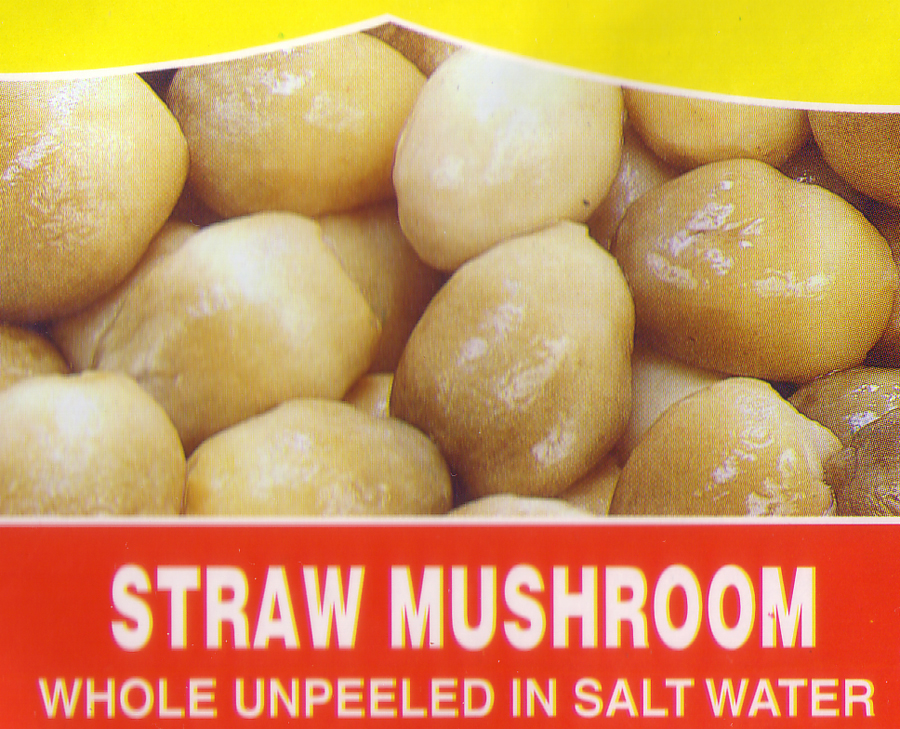
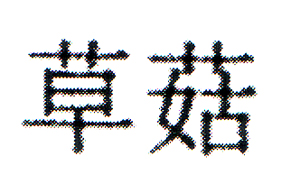 are also called paddy straw mushrooms, and known by their Japanese name of furotake. These fungi are one of the easiest to cultivate. Some reports discuss the small amount of toxicity in them. Fear not, because that is reduced by canning and/or cooking. Our advice, do not eat them raw.
are also called paddy straw mushrooms, and known by their Japanese name of furotake. These fungi are one of the easiest to cultivate. Some reports discuss the small amount of toxicity in them. Fear not, because that is reduced by canning and/or cooking. Our advice, do not eat them raw.
These roundish items are about the size of quail eggs and tan to brown becoming gray-black when overly mature. Straw mushrooms have no visible stem when young, their caps enclose them. Some cans of these mushrooms say they are peeled, others say their veils are removed; either way, check out the pictures and do taste them both ways.
Straw mushrooms are grown on paddy straw, hence their name. Not only are they found canned, they are seen refrigerated swimming in Asian markets near the fresh doufu. They taste little different than those taken out of a can; probably because they came out of an industrial-sized one.
In general, chefs and medical practitioners recommend heating before eating; now you know why. They are best friends with or without a batter coating, or when steamed, boiled, braised, or used in a stir-fry dish. Dried ones are easily reconstituted and used in any of the above ways. Growers report them one of the easiest mushrooms to raise. They can be on a table in just ten days after the spawn are inoculated into the paddy straw. The recipe for them and all mushrooms in this third part in the series, appear at the end of the article.
SWORDBELT mushrooms are now botanically known as 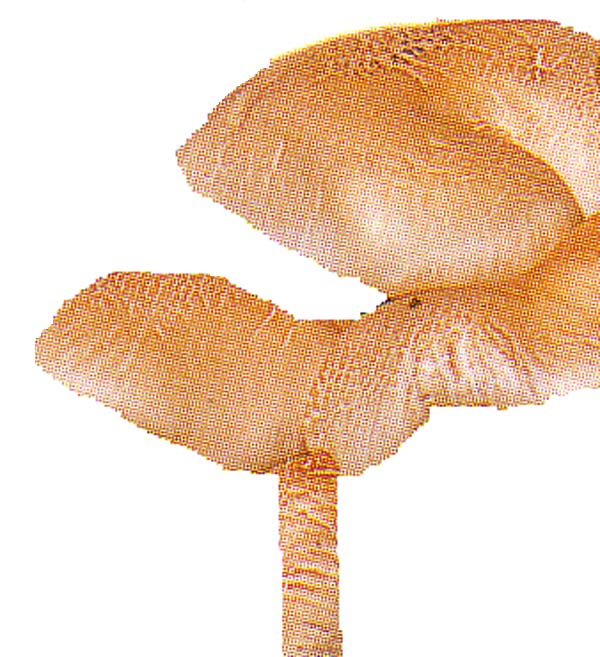
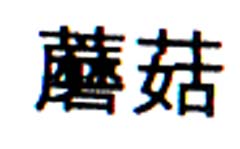 Agrocybe aegerita, but were once called Phiolata aegerita. Some say they have another botanical name, that of Cumellia sinensis. These mushrooms when found in the forest are often on poplar logs and stumps, and are long and thin, while the caps of older ones can be between two to five inches across. Also known as black poplar, magical, and brown swordbelt mushrooms, in Italy they call them the pioppino mushroom. In Japan, they are the yan agi maksutake mushroom. The Chinese sometimes refer to them as 'tea tree' mushrooms because one needs to look down on stumps or up on branches to find them. In Chinese, they call them cha shu gu or the zhu zhuang tian tou gu. Confused? So are many mycologists who sometimes report the cap rounded, sometimes convex, also depressed. Therefore, they can be found any of these ways.
Agrocybe aegerita, but were once called Phiolata aegerita. Some say they have another botanical name, that of Cumellia sinensis. These mushrooms when found in the forest are often on poplar logs and stumps, and are long and thin, while the caps of older ones can be between two to five inches across. Also known as black poplar, magical, and brown swordbelt mushrooms, in Italy they call them the pioppino mushroom. In Japan, they are the yan agi maksutake mushroom. The Chinese sometimes refer to them as 'tea tree' mushrooms because one needs to look down on stumps or up on branches to find them. In Chinese, they call them cha shu gu or the zhu zhuang tian tou gu. Confused? So are many mycologists who sometimes report the cap rounded, sometimes convex, also depressed. Therefore, they can be found any of these ways.
Most often they are found very small and on long skinny stems. In the woods, check on hardwood tree stumps. Commercially, they grow these mushrooms on rye, wheat, sorghum, and other cereal grain husks. When young the caps and stems are white; they gray as they age, then changing to tan and finally to brown.
When fresh, these mushrooms have very little water so half-pound fresh ones can be equal to half-pound of them dried. Be aware that low down on their stems, fresh or dried, one can find lots of dirt. Cut that away where they thicken near the tree or stump.
Said to have seventeen amino acids, these mushrooms are high in protein and said to be good for physical health. Thought to be anti-cancerous, folks love them when dried because of their intense flavor. When re-hydrated or when fresh, cook them longer than other mushrooms. The Chinese like them cooked; they do not cut their stems into smaller pieces even though they are firm and fibrous. Traditional Chinese medical practitioners advise they contain cardio-toxic proteins, so long cooking is a must, but how long is long? Ten minutes is what they recommend.
If using dried ones, soak them overnight. Do use them in stuffings and long-cooked dishes. They are adored with chicken or fish for their nutty flavor and for their aroma which some compare to a barrel or a cork. We love them prepared with Chinese rice wine and with other wines.
TURKEY TAIL mushrooms are yun shi in Chinese, 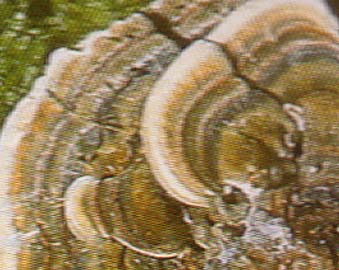
 while Corilus versicolor is their botanical name. Used for years in China for urinary infections and to reduce cancers that are tumor size, not all TCM practitioners seem to know this fact; most people do not either.
while Corilus versicolor is their botanical name. Used for years in China for urinary infections and to reduce cancers that are tumor size, not all TCM practitioners seem to know this fact; most people do not either.
Locating information about this mushroom is difficult because these polypores are now being called Trametes versicolor, a name very few books seem to use. They grow on the tops of stumps, and on thin trunks of all kinds of trees. Should you find any of these annuals in the woods, remember where because these mushrooms will return to the same stumps or branches many years in a row.
Turkeytail mushrooms have wavy edges, can be black, brown, red, violet, ochre, green, or all of the above, and when young they have thin bands of colors that start out being white. These fungi are thin and rarely shiny, and they do look somewhat like the reishi mushroom but with different bands of color. Furthermore, on the reverse side of the caps are short tubes, not gills.
Chinese have long used these fungi as tumor inhibitors, as antibiotics, and to treat hepatitis. We have seen them in museums and in a few books, but very few herbal stores seem to have them. Not one person we spoke had ever been asked for a whole one until we did. The herbal stores sell them powdered, not even in small pieces. TCM practitioners add them to assorted decoctions, to teas, soups, and stews, but they do not add them too often. Below is a recipe for them in capsule form as we found them in one herbal emporium.
WHITE CLAM mushrooms have many names. 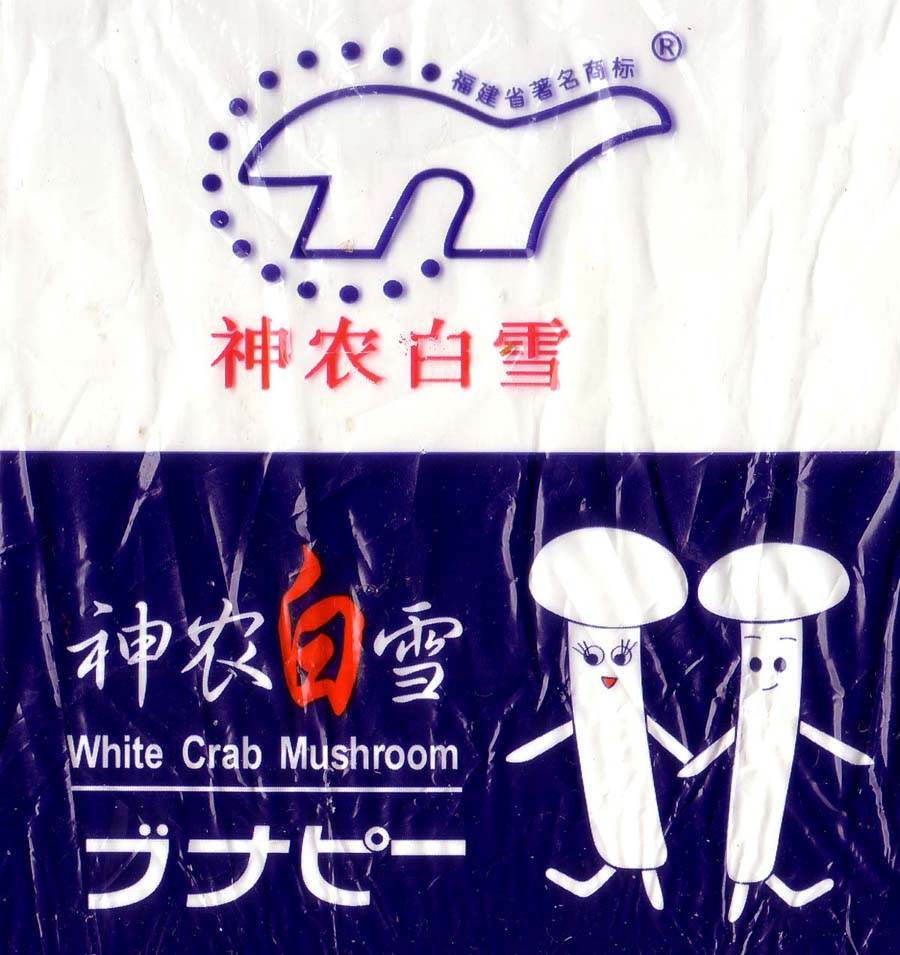 In a local supermarket, the only place we did find them, they were organic and were called 'bunapi' mushrooms or white clam mushrooms. They are now known as Hypsizygus tessulatus which is their botanical name; but it has changed over time as they were once known as Hypsizygus marmoreus. Actually, their name differs depending on where you read about them or whom you believe. They a commonly available brown, and only recently have been found white or brown or both in retail markets. Sometimes called 'crab mushrooms,' they have been used for a long time by the Japanese who call them hinshimeji or muna shimeji, bot names we have seen them called. Paul Stamets, a well-known mycologist, says they look like young Lyophyllum and that is one reason for the many confusions about them.
In a local supermarket, the only place we did find them, they were organic and were called 'bunapi' mushrooms or white clam mushrooms. They are now known as Hypsizygus tessulatus which is their botanical name; but it has changed over time as they were once known as Hypsizygus marmoreus. Actually, their name differs depending on where you read about them or whom you believe. They a commonly available brown, and only recently have been found white or brown or both in retail markets. Sometimes called 'crab mushrooms,' they have been used for a long time by the Japanese who call them hinshimeji or muna shimeji, bot names we have seen them called. Paul Stamets, a well-known mycologist, says they look like young Lyophyllum and that is one reason for the many confusions about them.
We have read about them as brown beech, white beech, chaoda, bunapi-shimeji, mountain echo mushrooms, and elm oyster mushrooms. Often we see them as Muna shimeji when brown, and bunapi when white. Elizabeth Schneider, in her book about vegetables, says they have thin caps, ivory gills, tender stems, and that they need no cleaning. She says to expect variation from grower to grower, and she recommends preparing them as one would button mushrooms.
What we found about using this mushroom for health purposes is that some research was done on mice. After they ate them, they lowered their serum cholesterol, reduced arteriosclerosis, increased immune stimulation, and also reduced their numbers of cancers. Those researchers said these changes were due to their many medically active compounds.
We did find some white beech mushrooms from the Fujian province, others from Shanghai. We cooked them both and thought they tasted terrific. We used them in stir-fried dishes, in steamed and in long-cooked ones, and preferred them whole but did cut off the bottom half-inch where they bunch together as that area was loaded with dirt. To date, we have not seen any Chinese recipes for them, and we will welcome learning from readers who have.
Seems most beech mushrooms are cultivated, at least those we found in the marketplace were. Mycologists tell us these mushrooms can be collected in the wild but many will look different. Want to learn more, go to a website that specializes in them; it is at: www.goldengourmetmushrooms.com/beechmushrooms.html
FOR MORE INFORMATION about the health-giving features of any of the mushrooms in any of these articles or elsewhere, visit websites, local libraries, and several herbal stores. To get started, go to: http://tcm.health-info.org/Herbology.Materia.Medica/baixianpi-ptoperties.htm
A book that just came across our desk with a 2008 copyright is another good place to start to learn about the health aspects of these food items. It is Mushrooms as Functional Foods by Peter C.K. Cheung, its editor. The publishing information is that it is produced in Hoboken NJ by John Wiley & Sons Inc.; its ISBN is 978-0-470-05406.
MUSHROOM SPORE information is availale at any or all of the following:
The folks at 475 Northern Blvd # 36 in Great Neck NY 11021; also
Fork, Fingers & Chopsticks at PO Box 70015 in Sunnyvale CA 94086; and
Fungi Perfecti at PO Box 7634 in Olympia WA 98507;
International Journal of Medicinal Mushrooms at www.begelhouse.com/ijmm.html is another source; the
Maitaki Products at PO Box 1354 in Paramius NJ 07653; and
The Mushroom Council at 11875 Dublin Blvd. in Dublin CA 94568.
GOLDEN OLDIE BOOKS include: Mushroom Biology and Mushroom Products edited by Shu-tine Chang, John A. Boswell, and Siu-wai Chiu. It is published by the Chinese University Press in Hong Kong in 1993, its ISBN 962-201-610-3.
The Encyclopedia of Mushrooms by Colin Dickinson and John Lucas. It was published by Crescent Books in New York in 1983; its ISBN 0-517-374846.
The Great Encyclopedia of Mushrooms by Jean Louis Lamaison and Jean-Marie Polese was published by Konemann in Konegswinter, Germany in 2005; its ISBN 3-8331-1239-5.
The Growing Gourmet and Medicinal Mushrooms is by Paul Stamets and published by Ten Speed Press and Mycomedia in Berekley CA in 1993; its ISBN 0-89815-608-4, and
The Ultimate Mushroom Book by Peter Jordan & Steven Wheeler is published by Smithmark Publishers Inc. in New York in 1995; its ISBN 0-8317-3080-3.
And now one recipe for each of the above mushrooms followed by a few classic ones using more than one kind of mushroom:
| Celtuce and Straw Mushrooms |
|---|
3 celtuce, peeled, then cut into two-inch long pieces, the thicker bottom parts can be cut in half or quartered 1 cup canned straw mushrooms, (half not peeled and half peeled to add texture, optional) 1 Tablespoon vegetable oil 1 red pepper, seeded and cut into half-inch squares 1 Tablespoon vegetarian oyster sauce 1/2 teaspoon mushroom bouillon 1 teaspoon sesame oil 1 teaspoon cornstarch mixed with two teaspoons cold water Preparation: 1. Rinse celtuce pieces, and set aside. Do likewise to both straw mushrooms, drain them, and mix the mushrooms together. 2. Heat wok or fry pan, add the oil and stir-fry the celtuce for one minute, then add mushrooms and the red pepper pieces and stir-fry for another minute or two, until all are heated through. 3. Then add the vegetarian oyster sauce, bouillon powder, and the sesame oil, and stir for half minute. Bring this to the boil, then add cornstarch mixture and stir until the sauce clears, about half minute. Then serve. |
| Swordbelt Soup |
|---|
1/2 cup dried swordbelt mushrooms 1 teaspoon salt 1 cup minced beef 1 teaspoon thin soy sauce 1/2 teaspoon sugar dash ground white pepper 1 teaspoon cornstarch 1 stalk Chinese celery, cut into one-inch long thin strips 3 two-inch pieces green and white large radish, peeled and thinly sliced, then blanched for one minute until pliable 1/2 cup bok cai leaves Preparation: 1. Soak swordbelt mushrooms with salt and two cups water for one hour, then rinse and discard the water. Set the longest ten mushrooms aside, cutting off their caps and reserving them, mince the other mushrooms. 2. Mix minced beef, soy sauce, sugar, pepper, and cornstarch, and spread this on ten or twelve slices of the blanched radish. Roll them up and tie each one with a mushroom. 3. Bring five cups water to just under a boil, gently add the tied mushroom packages, the celery sticks, and simmer for five minutes, then add the bok cai leaves and simmer another four or five minutes, then serve the mushroom packages, one to a person, some leaves, and some liquid in a soup bowl to each person. |
| Tricolor Mushroom Pockets |
|---|
5 tri-color mushroom capsules 1/2 cup ground pork or beef 1/2 cup peeled shrimp 2 scallions, minced 2 slices fresh ginger, peeled and minced 1 Tablespoon Chinese rice wine 1 teaspoon sugar 1 Tablespoon grinding bean sauce 1 teaspoon sesame oil 1 clove garlic, peeled and minced 1 slice fresh ginger, peeled and minced 3 Tablespoons Thai basil 1/2 teaspoon chili paste with garlic 40 dumpling wrappers 2 Tablespoons vegetable oil Preparation: 1. Empty ground tri-color mushroom capsules and mix the contents with the minced meat and shrimp, the scallions, ginger, rice wine, sugar, bean sauce, sesame oil, garlic, ginger, basil and the chili paste. 2. Put one tablespoon of this mixture on a dumpling wrapper, and fold to make it look like a pocketbook, sealing the edges with a little water. Set all of them aside for half an hour, in the refrigerator. 3. Heat a fry pan, add the oil and half the dumplings and brown them on their bottom side. Reserve any oil leaving it in the pan. 4. Bring four cups of water to the boil, reduce the heat and add the pockets, reducing the heat, and let them simmer for six or seven minutes, then drain, and gently put them in the pan with the reserved oil, and stir until they are coated, then serve (with a sauce on the side, if desired). |
| Steamed Many Mushroom Dumplings |
|---|
40 dumpling wrappers 5 Tablespoons each, minced any five mushrooms 5 Tablespoons matrimony vine, minced 1 Teaspoon salt 1 Tablespoon granulated sugar 1 Tablespoon cornstarch Preparation: 1. Mix all the ingredients except the dumpling wrappers. then fill them as done in the Tricolor Pill Pocket recipe. 2. Follow all other steps to the end, then brown them on one side, then boil them for four to five minutes, and serve. |
| Mushrooms and Hair Vegetable |
|---|
10 medium-size dried Chinese black mushrooms, stems removed and discarded 2 Tablespoons Chinese rice wine such as shaoxing wine 1 teaspoon coarse salt 1 teaspoon sugar 1 Tablespoon vegetable oil 1 can straw mushrooms, drained 1 cup chicken or vegetable stock 1 cup button mushrooms 1 large leaf fresh lettuce 1 Tablespoon oyster sauce or an imitation oyster sauce 1 Tablespoon cornstarch mixed with two teaspoons cold water 1 teaspoon rendered chicken fat or a solid shortening 1 ounce hair vegetable (fa cai) 1/4 cup enoki mushrooms, cut just above where they attach to each other, and blanched for half minute in boiling water Preparation: 1. Put black mushrooms, rice wine, salt, and sugar in a small bowl and steam over boiling water for half an hour. 2. Heat wok or fry pan, add oil, then the straw mushrooms, stock, and the button mushrooms and stir-fry for fifteen minutes, then add the cornstarch mixture, and stir-fry until thickened. Then drain and reserve that liquid before mixing with oyster sauce and chicken fat. Drain once again, just leaving enough to coat the mushrooms. Set them on the lettuce leaf on a platter. 3. Rinse and drain the hair vegetable, simmer for two minutes in the reserved liquid, put this over the mushrooms, and top with the enoki mushrooms, then serve. |
| Bean Curd Sticks and Many Mushrooms |
|---|
2 dried beancurd sticks, soaked for half hour, hard parts cut away and discarded, remaining softened sticks sliced into half-inch pieces 3 small cans (assorted types) mushrooms, drained 1 carrot, peeled and sliced thinly on angle 6 shallots, peeled and cut into quarters 1 Tablespoon vegetable oil 1 teaspoon Chinese rice wine 1 teaspoon mushroom oyster sauce 1 teaspoon thin soy sauce 1 teaspoon sugar 1 Tablespoon water chestnut flour 1 teaspoon cornstarch 1/2 teaspoon sesame oil Preparation: 1. Drain bean curd pieces and dry with a paper towel. Then mix them with mushrooms and set aside. 2. Simmer carrot slices in half-cup water for two minutes, then drain and set them aside. 3. Heat vegetable oil, add pieces of beancurd and all the mushrooms, and the shallots and carrot pieces and stir-fry for two minutes before adding mushroom oyster sauce, thin soy sauce and the sugar, and stir well. Next mix the water chestnut flour with the mushrooms, and the cornstarch with one tablespoon cold water before adding it to the mushroom mixture. 4. Stir in the sesame oil, put the mushroom mixture in a bowl, and serve. |
| Peas and Mushrooms |
|---|
1/2 pound snow peas (or melting mouth peas) strings removed 1/2 cup sliced bamboo shoots 1 small can abalone mushrooms, drained, each cut in half, if they seem too big 1 small can golden mushrooms, drained 12 button mushrooms, each cut in half 1/2 cup each of other mushrooms of choice; it they are canned, drain them 1/2 cup cold chicken stock 3 Tablespoons oyster sauce 1 teaspoon sugar 2 Tablespoons cornstarch 1 Tablespoon dark or mushroom soy sauce 2 Tablespoons vegetable oil or lard or chicken fat Preparation: 1. Rinse and dry peas, and mix them with the bamboo shoots, and set aside. 2. Dry all mushrooms, if canned, with paper towels and mix them together with the peas mixture above. 3. Mix chicken stock, oyster sauce, sugar, and the cornstarch and set aside. 4. Heat wok or fry pan, add oil or another fat, and fry the pea/mushroom mixture for three minutes, then add the chicken stock. Stir-fry until thickened, then serve. |

Copyright © 1994-2025 by ISACC, all rights reserved
Address
3 Jefferson Ferry Drive
S. Setauket NY 11720